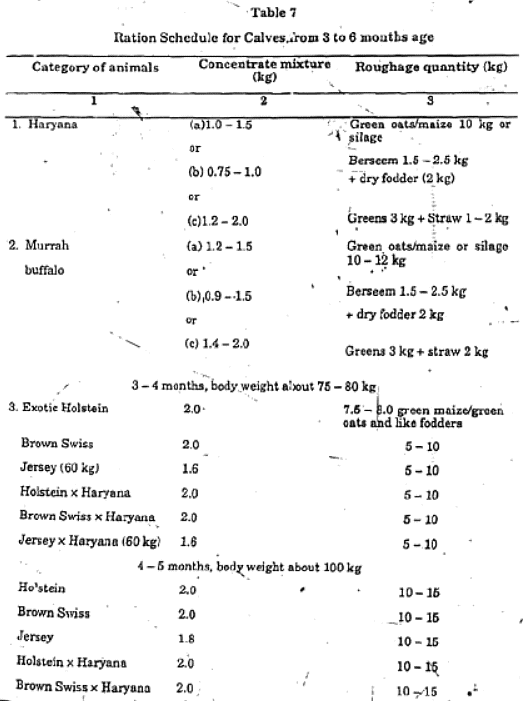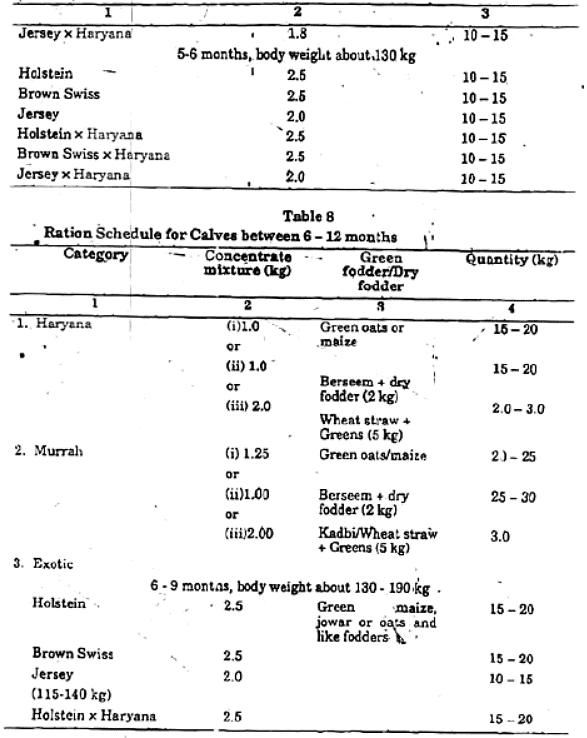Feeding Regiments for Dry and Young Stock and Bulls | Animal Husbandry & Veterinary Science Optional for UPSC PDF Download
Feeding and Management of Dairy Calves
- Crucial Aspect of Dairy Farming:
- Feeding and managing dairy calves is a vital part of successful dairy farming.
- Early Care for Growth:
- Calves receiving excellent care from birth grow into robust animals.
- Well-nourished, vigorous calves at six months are more disease-resistant and have better potential for usefulness.
- Nutrition Influences Development:
- Higher nutrition levels lead to earlier puberty, resulting in quicker returns on investment.
- Reticulorumen Capacity:
- The reticulorumen, or fermentation vat, has a 2-liter capacity at birth.
- Access to plentiful milk reduces the need for additional feeds.
- Early Introduction of Roughage and Concentrates:
- Introducing roughage and concentrates early aids microbial population development in the rumen.
- Enables utilization of coarse fodders and starchy foods for energy.
- Energy Requirements in Calves:
- Calves have higher energy requirements per unit of body weight compared to adult ruminants.
- Addition of high-quality proteins is advantageous until the rumen functions optimally.
- Rumen Development and Synthesis:
- Fully functional rumen synthesizes B-complex vitamins and vitamin K, reducing the need for these in the diet.
- Essential Nutrient Considerations:
- Adequate supply of calcium, phosphorus, sodium, potassium, and other essential nutrients is crucial.
- Digestive Tract Development Knowledge:
- Understanding the development of the digestive tract has helped in creating economical and convenient calf-rearing systems with solid foods.
Feeding and Management of Dairy Calves
- Birth Weight Significance:
- Birth weight is crucial for determining a calf's maximum potential weight gain.
- Feeding Schedule for Calves:
- General feeding schedules are established for economically feeding calves from birth.
- Milk allowance is calculated based on body weight, with adjustments over the first few weeks.
- Weaning Importance:
- Weaning should ideally occur at birth or by the fourth day to ensure proper milk intake.
- Balancing milk quantity is essential to avoid both under-feeding and over-feeding, which can harm the calf.
- Colostrum and Milk Feeding:
- Calves receive colostrum from their dam within 8-12 hours after birth and then twice daily for three days.
- Boiled milk, equivalent to the calf's body temperature, is fed in two equal halves in the morning and evening.
- Antibiotics can be administered with milk or mixed with calf starter.
- Training and Access to Feed:
- Calves may need initial training to consume milk from an open pail during the first few days.
- By one week of age, calves should have access to calf starter, mineral supplements, and good-quality forage in their pens.
- Transition to Skim Milk and Milk Replacer:
- Skim milk may substitute whole milk around five weeks of age.
- Gradual transition is important to allow the calf to adjust to the taste of milk replacer.
- Milk replacer is a cost-effective feed with a composition similar to milk, providing necessary nutrients.
- Calf Starter Feed:
- At 90 days of age, calves transition to calf starter, a concentrated mixture with high protein content.
- Calf starters may contain 22% protein and 70% total digestible nutrients (TDN).
- Adjustments can be made based on regional feed availability.
- Rumen Development:
- By 90 days, calves should weigh 50-60 kg (females) or 60-70 kg (males) and develop microbial fermentation in their rumen.
- Regional Adaptations:
- Calf starter formulations can be adapted based on regional feed availability.
- Gradual Transitions:
- Changes in diet, such as transitioning from milk to calf starter, should be gradual to ensure calf adaptation and optimal growth.
Calf Starter Composition and Feeding
- Common Calf Starter Composition: A commonly used calf starter includes:
- Crushed barley (50 parts)
- Groundnut cake (30 parts)
- Wheat bran (8 parts)
- Fish meal/Dried skim (10 parts)
- Mineral mixture (added to make 100 kg)
- Additions to Calf Starter:
- Molasses (5-10%)
- Revimin (10 g per quintal)
- Salt (0.5%)
- Aureomycin (20 g per quintal)
- Variations in Barley:
- Barley fraction can be replaced by maize, oats, sorghum, millet, etc., based on availability.
- Other Calf Starter Compositions:
- Cottonseed (20 parts)
- Fish meal (20 parts)
- Crushed maize (50 parts)
- Feeding at 90 Days:
- At 90 days, calves are given high-quality succulent fodder ad libitum and 1 kg of concentrate mixture.
- Roughages for Early Development:
- Early introduction of quality hay or leguminous green fodder helps in the early development of rumen functions.
- Commonly used fodders include berseem, oats, barley in Northern India, and maize, cowpea, and sunhemp in South India.
- Energy and Protein Sources:
- At 3 months of age, calves can receive adequate energy and protein from calf starter and quality forage, even without milk feeding.
- Estimated Consumption from Birth to 3 Months:
- Colostrum: 7.5 kg
- Milk: 82.75 kg
- Skim milk: 59.30 kg
- Calf starter: 56.35 kg
- Hay: 59.85 kg
- Flexible Formulations:
- Calf starter formulations can be adapted based on local feed availability and preferences.
- Gradual Modifications:
- Feeding practices can be modified or increased gradually as calves grow, ensuring their nutritional needs are met for optimal development.
Feeding Young Stock (Above Six Months to Maturity)
- Development at 6 Months:
- Weight: 100-150 kg.
- Fully developed rumen, capable of using forage effectively.
- Over 70% of bulk and energy needs fulfilled by forage.
- Nutritional Balance:
- Remaining 30% of bulk and energy, and 70% of protein needs met by concentrate mixture.
- One Year to 18 Months:
- Expected weight at one year: 150-250 kg.
- Expected weight at 18 months: 200-300 kg, given proper care and nutrition.
Importance of Good Care
- Proper nutrition crucial for healthy growth.
- Balanced diet ensures optimal development.
- Weight milestones indicate successful feeding and care practices.
In Illustrations to are given, examples of ration for various weights.






Daily nutrient requirements for growth of calves have been worked out and are available. Based on this it is possible to calculate growth ration for different ages. Studies have shown that when straw constitutes the basic roughage, a rate of growth as high as 0.8 to 10 kg can be attained by feeding nearly 2.5 to 3 kg of concentrate mixture with as little as 2.5 kg of green berseem and about 2 kg straw in cattle and buffalo calves past 200 kg body weight. On a ration of this kind sabu calves and heifers show maturity at two years and crossbred calves at 18 months. If in a ration 50 to 60 per cent of total dry matter is substituted by concentrates only, the rate of growth is very much increased resulting in earlier maturity.
The ration schedule recommended for calves of different ages is given in Tables 7 to 9:




Water Intake for Calves
- Dependency Factors:
- Water intake influenced by dry matter intake, ambient temperature, and diet salt and protein content.
- Milk Intake Impact:
- Restricted milk intake increases water consumption in calves during the first 60 days.
- Averages about 6 kg in winter and 5 kg in summer per kg of dry matter from milk, calf starter, and roughage.
- Exotic calves generally have higher water intake than indigenous ones.
Feeding Dairy Cows
- Indigenous vs. Exotic Breeds:
- Indigenous cattle produce an average of 200-400 liters with a peak yield of 3-4 kg per day.
- Crossbred cows yield 2400-4000 liters with a peak of 30 liters per day.
- Feeding Objectives:
- Primary goals: maintain the cow, support growth if not at mature weight, provide nutrients for calf production, and ensure optimal milk secretion.
- Nutrient requirements detailed in tables for reference.
- Maintenance and Production Needs:
- Previously assumed maintenance requirements were the same for dry and lactating cows.
- Recent findings suggest high-producing animals have double maintenance needs during lactation.
- NRC recommends a 3% feed increase for each 10 kg of milk produced above 20 kg/day.
- Ration Components:
- Dairy cow ration typically divided into maintenance and production parts.
- Maintenance depends on body weight, and production relies on milk level and composition.
Feeding Systems for Cattle
- Green Fodder System:
- Feeding animals with fresh, leafy crops like maize or jowar.
- Ensures nutritional needs are met through natural sources.
- Green Grass/Grass Hay System:
- Utilizing green grass or dried grass as a primary feed.
- Provides essential nutrients for cattle.
- Straw and Ster-Based Rations:
- Using straw and other plant-based materials for feed.
- Offers an alternative, especially when green fodder is scarce.
Feeding Dry Animals
- Dry cows, not pregnant or producing milk, still need a basic maintenance ration.
- For a 400 kg cow, feeding 25 kg of green maize or quality jowar fulfills maintenance requirements.
Feeding Pregnant Animals
- Ideal calving intervals are yearly with a 300-day lactation and a 60-day dry period.
- During the dry period, cows need nutrients for body reserve buildup and fetal growth.
Steaming Up
- Dry cows receive increased concentrates, peaking in the last 6 weeks of pregnancy.
- Enhances milk production and prepares the cow for post-calving concentrate-rich diets.
Feeding Heifer Cows
- Crossbred cows calve earlier (24-30 months) compared to purebred cows (around 40 months).
- Additional growth allowance of 0.5 kg concentrate per day during the first lactation supports their continued growth and milk production.
Feeding Breeding Bulls
Nutrient requirements for Breeding Bulle: When the bulls are already developed, they are normally fed on maintenance requirements. The nutrient requirements on the basis of NRC 1971 is as given below:

When Berseem/Lucerne Crops are Present
If there is access to berseem/lucerne crops, they can be included in the diet along with other high-quality forages like oats, eliminating the need for additional concentrates. When these crops serve as the primary roughage, concentrates are not required.

FAQs on Feeding Regiments for Dry and Young Stock and Bulls - Animal Husbandry & Veterinary Science Optional for UPSC
| 1. What is the composition of calf starter and how should it be fed to dairy calves? |  |
| 2. What are the key considerations when feeding young stock from six months to maturity? |  |
| 3. How much water should calves consume and why is it important for their development? |  |
| 4. What factors should be considered when feeding dairy cows? |  |
| 5. What are some common feeding systems for cattle and their benefits? |  |















